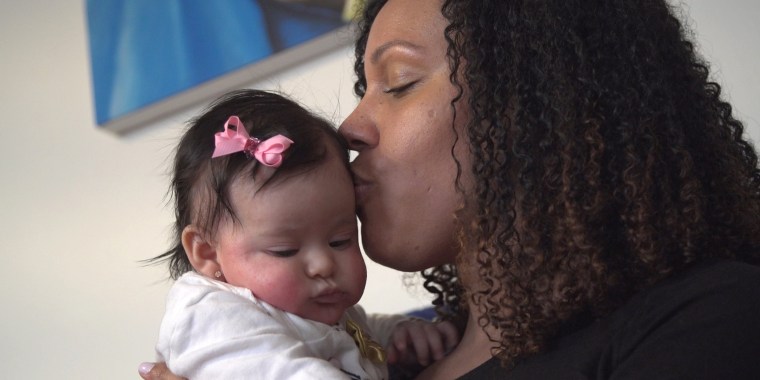No one ever said life was fair — but for many women who have given birth, the injustices dealt to their undercarriages are legion.
They might not ever talk about it, and they might not realize how common their conditions are, but untold numbers of moms out there:
- pee when they sneeze, laugh, run or jump;
- struggle with lower back pain;
- feel pain during sex;
- experience pain when they try to lift or carry their kids;
- feel self-conscious about the way their bellies protrude because their abdominal muscles have separated, or
- have the sensation that something is putting pressure on — or maybe even falling out of — their vaginas, because something is: their organs.
For a very long time, women have accepted these conditions as the unavoidable price of giving birth. These days, though, a new generation of moms and medical professionals is speaking up and saying: Oh no, sister. You have no reason to be embarrassed, and your life doesn’t have to be like this.
“Why should we be ashamed?” said Theanne Griffith, 32, a postdoctoral scientist at Columbia University and a children's book author who began having pelvic floor problems after the birth of her second daughter. “We brought this beautiful, beautiful being into the world and our bodies suffered because of it and that’s OK. I think that if people just start having the conversation then the shame goes away because you realize how many people really, at some point, will be affected by this.”

According to the Herman & Wallace Pelvic Rehabilitation Institute, one in five women experience pelvic floor problems after the birth of their first child. It’s even more likely after the arrival of a second or third baby. Such problems may be common, but they’re not at all normal — and, in many cases, they’re fixable.
“So many women are not informed or aware about any of this,” said Holly Tanner, a physical therapist in Seattle and Herman & Wallace’s director of education. “They’ll hear from other women that what’s happening to them is inevitable and can’t be treated — but it can be.”
So much more than Kegels
A struggling mom can start feeling better just weeks after seeing a physical therapist who specializes in pelvic floor issues. If she needs help strengthening key muscles, she can be shown how to firm them up. If she needs help relaxing tight muscles, she can learn how to let them go. Many women need assistance rebuilding their core strength, breathing correctly and understanding how to contract and relax the right muscles at the right time.
Urogynocologists also can help immensely. These doctors specialize in pelvic floor disorders and can determine when surgery might be warranted.

In all cases, treatment plans need to be tailored for specific individuals. It’s a lot more nuanced than the one-size-fits-all advice women often get: “Do Kegel exercises.”
“The number one thing people ask is, ‘How many Kegels do I have to do in order to prevent things from happening post-partum?’” said Stacey Futterman Tauriello, a physical therapist and pelvic-floor specialist in New York and New Jersey. “That’s a hard question to answer because Kegels aren’t the number one thing we tend to tell people to do. There’s so much more that we can do post-partum to get women to be stronger and to be functional.”
Griffith, a Columbia University scientist and mom of two, began experiencing three uncomfortable conditions around the arrival of her youngest daughter, Lila, last November: pelvic organ prolapse, diastsis recti and debilitating back pain.
Pelvic organ prolapse describes the descent of the pelvic organs toward the vaginal opening; in Griffith’s case, the organ falling into her vaginal canal is her bladder.
“Very unpleasant!” she said with a laugh.

Diastasis recti is a separation of the abdominal muscles. It’s a frustrating condition that can leave women with the appearance of being pregnant months after giving birth.
Between her belly pooch, her back pain and the nagging feeling that something was hanging in her vagina, Griffith began to worry that she might never feel like herself again. Then she visited Kenael Segal, a physical therapist in Cedar Grove, New Jersey.
“The first time I went, she asked me a bunch of questions and did an internal exam, similar to a gynecology exam,” Griffith said. “That way she could feel my pelvic-floor muscles and feel where they’re tight. She loosened them and they don’t hurt anymore.”
Griffith also does mild physical therapy exercises and attends a Pilates class to strengthen her core and alleviate her back pain. “It’s been great,” she said. “I’m feeling so much better now.”
Let's talk about leaking
Segal personally had experienced pelvic floor dysfunction after the birth of her son, Aldo, six years ago, so she knew how to help Griffith with the kinds of issues she was having. Segal said she also sees lots — repeat, LOTS — of patients who leak urine.
“I’ve had women who say, ‘I don’t HAVE to jump on the trampoline with my kids,’” Segal said. “No, you don’t, but wouldn’t it be more fun to be able to participate in these things with your kids without having to worry?
“Think about what your 80-year-old self would say to yourself now. Would she thank you for taking care of this and strengthening those muscles when you were younger, or would she be upset that you waited way too long until you had no control? Remember that the number one reason for admitting people into a nursing home is incontinence. It could have been something that was never addressed, but that could have been addressed.”

Segal said many of her patients feel motivated to do their prescribed physical therapy exercises when she lets them know about another fringe benefit of treatment.
“When you tell women, ‘If your pelvic floor muscles are strong, you’ll have better orgasms,’ they’re like, ‘Yeah, let’s do this!’” she said.
Never miss a parenting story with the TODAY Parenting newsletter! Sign up here.
Chronic conditions don't have to mean chronic fear
Haley Shevener, 32, is a personal trainer and strength and conditioning coach in San Francisco. She’s helped scores of pregnant women and moms with pelvic floor dysfunction to continue exercising and doing other activities they love to do.
Shevener was in such peak physical condition before the arrival of her own son four years ago that she expected to bounce right back after giving birth.
“I had a loooooong labor: 60 hours," she recalled. "I did have a vaginal birth, but it wasn’t the idyllic experience I imagined it would be.”
Several months after her son was born, Shevener learned that she had pelvic organ prolapse, or POP. In her case, her condition is chronic.
“I live with that reality every day,” said Shevener, who grappled with depression after her diagnosis. “I’m much better than I was, but I’m not cured.”
Today, Shevener is channeling her energy about POP into something positive: helping other women with the condition understand how to manage it. She runs an Instagram account and a Facebook group dedicated to pelvic floor issues, and she’s co-created an extensive online course called POP UP: An Uplifting Guide to help women cope.
“A diagnosis like this can be so scary, but there really is hope,” Shevener said. “There’s no reason to live with fear.”
How to find help
To locate pelvic floor treatment options near you, search for urogynecologists in your area, or find specialized physical therapists via these websites:
- Herman & Wallace Pelvic Rehabilitation Institute
- American Physical Therapy Association (After typing in your location, filter for “women’s health.”)
To learn about an array of pelvic floor disorders, including bladder- and bowel-control issues, visit the website of Voices for PFD.
To learn more about pelvic organ prolapse and take an online course about how to manage it, check out POP UP: An Uplifting Guide.


